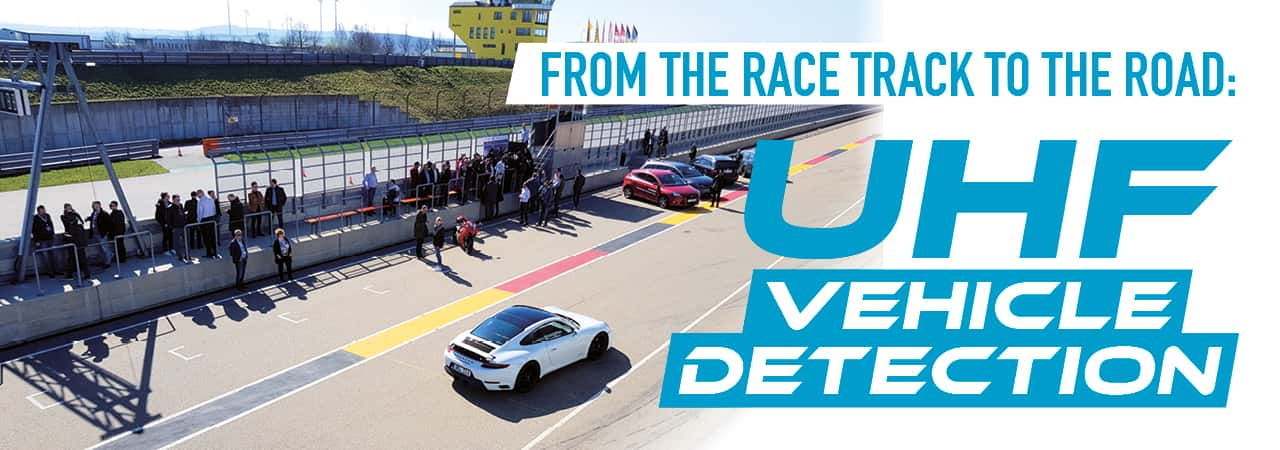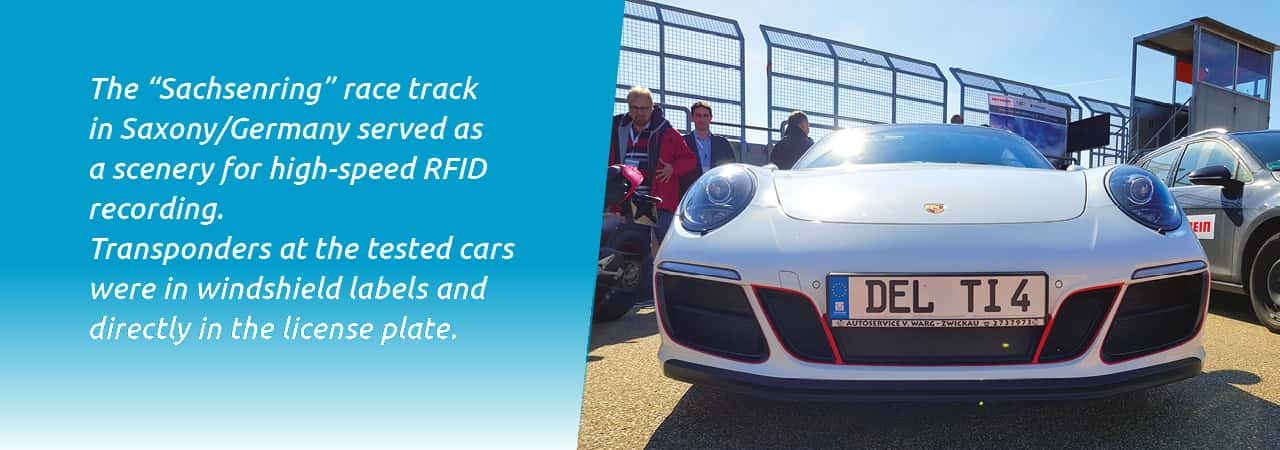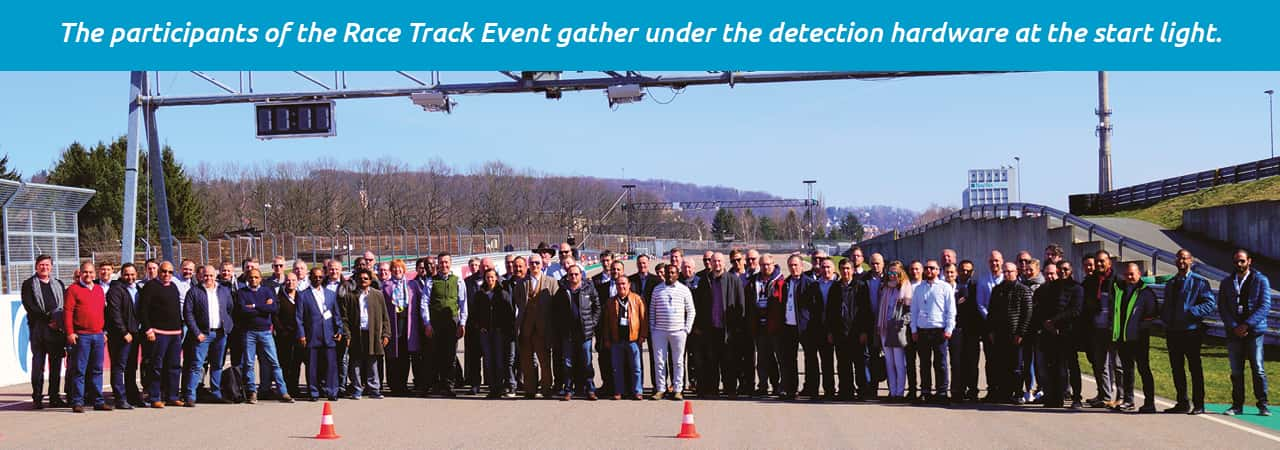Tönnjes, Kathrein, and NXP present UHF technology for AVI applications at the Sachsenring
More than 80 participants from more than 25 countries, including Argentina, Trindad and Tobago, Ethiopia, Qatar, Uzbekistan, the Netherlands, Italy, and Thailand, took advantage of the Race Track Days organised by Tönnjes together with Kathrein Solutions and NXP Semiconductors to see state-of-the-art UHF vehicle detection live.
The chosen venue – the Sachsenring racetrack – did not allow for any other option: the RFID technology had to show the performance it was capable of at high speed.
On track at the Sachsenring, RFID & Wireless IoT Global spoke with the responsible people at Tönnjes and Kathrein Solutions
Three license plates are better than two
Tönnjes has raised vehicle identification to a digital level. The solution called "IDePLATE" is a classic number plate with an integrated UHF RFID transponder. The highlight: the license plate surface serves as an antenna and enables a high reading range. In addition to number plates with transponders, special windshield transponders have been developed.
As Jochen Betz, Managing Director of Tönnjes, explains: "We always recommend a complete solution consisting of three identification features on a car or truck: front and rear license plates with transponders and a tamper-proof windshield label. Three RFID transponders on the vehicle triple the chance of detecting a vehicle in any situation."
When asked about the reliablility of the function even in inhospitable weather conditions, Thomas Brunner, Managing Director, Kathrein Solutions, gave detailed insights:
"With regard to the windshield labels, the tests that have been carried out for years and the experience gained from a large number of applications that we have implemented show that the period of a normal wiping interval of the windshield wipers in snow or rain is perfectly sufficient to record the label flawlessly. Only when a completely frozen, thick coating of slush and road dirt has formed on the front license plate can the transponder no longer be read with its maximum range.
Three transponders are standard on the vehicle – two license plates, and one windshield label as a 'third license plate'. This guarantees 100 percent secure detection."
Dynamic encryption even at over 200 km/h
Capturing a transponder ID during an antenna gate passage poses no technological challenge. However, the number plates and windshield labels of Tönnjes use the UCODE DNA chip from NXP Semiconductors, which enables dynamic cryptographic authentication. Christian Schnebinger, Senior Sales Manager, Kathrein Solutions, explains the challenges:
"In contrast to pure TID capture, the UCODE DNA only allows access to stored data if the reader has the corresponding cryptographic keys. The data is decrypted, sent, and re-encrypted on the transponder as it passes through the gate even at over 200 km/h. The latest generation of Kathrein RFID reader hardware is used to ensure that this process is absolutely secure, even at high speeds."
Fully exploit the potential of AVI
"Whether in the Philippines or Senegal, our contacts are the local ministries or authorities for vehicle registration," reports Jochen Betz, and explains:
"Vehicle registration is a sovereign task in every country worldwide. We use the Race Track Event to present the latest state of the art to customers and interested parties. On the other hand, our partners like Kathrein Solutions will provide insights into applications that are possible on the basis of UHF vehicle detection. The spectrum ranges from toll solutions and parking applications to registration checks, searches for stolen vehicles, and loyalty systems."
Testing the limits of technology
The developers of the participating companies used the time on the race track to test all facets of the technology and further refine the matching configurations of antennas, readers, and hardware, as Patrick Hartmann, Sales Director, Kathrein Solutions, explains:
"We set up two different setups, each with different generations of antennas, over the start-finish straight. The crosstalk agent runs on the RFID readers used. It compares the recorded raw data of the RFID system with those of the installed high-speed camera and combines them to form an event. During the test drives, different scenarios are simulated on the basis of a specific ISO standard for vehicle detection to ensure reliable detection in every conceivable traffic situation."
Christian Schnebinger adds: "We first ran tests at 70 km/h, then at 120 km/h on two parallel lanes according to the ISO standard. Finally, we ran a tes at the maximum speed that was possible from the Queckenberg curve exit on the longest straight of the course to the RFID gate with a total of 780 meters. The Porsche 911 GTS 4 reaches a speed of about 225 km/h, the Ducati Panigale up to 235 km/h. The recording worked perfectly."
The police began a pursuit...
... but only to vividly demonstrate how RFID data from vehicle recording can be used for safety-relevant applications.
"If a vehicle is reported stolen or suspected in the database, RFID readers at toll collection points can immediately forward a report to the responsible authorities. The search is supported and accelerated," explains Jochen Betz.
There is an important reason why the high-speed tests are not only carried out for the fun of fast driving, says Thomas Brunner:
"General speed limits apply in almost every country in the world. Nevertheless, authorities are demanding that RFID-based vehicle detection must also be possible at speeds of 200 km/h and more. A simple bypass of the detection due to excessive speed should be decisively counteracted. In tests on high-speed lines, in the past we were already able to achieve detection at up to 300 km/h, but only reading the EPC code without additional encryption algorithms."
"With our latest reader firmware and new antenna types, we have now achieved a breakthrough that enables stable end-to-end security detection at over 200 km/h."






